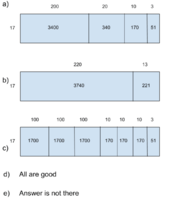I haven't done rectangular array division ever in my life, and after watching some videos I'm still at a complete loss as to how to do this problem. My hunch was answer C, because it seems to make the least amount of sense. Can someone help guide me through this problem? Again, I am completely unfamiliar with rectangular array division.
If we are to divide 3961 by 17 using a rectangular array, which of the following is NOT a good model?
If we are to divide 3961 by 17 using a rectangular array, which of the following is NOT a good model?

